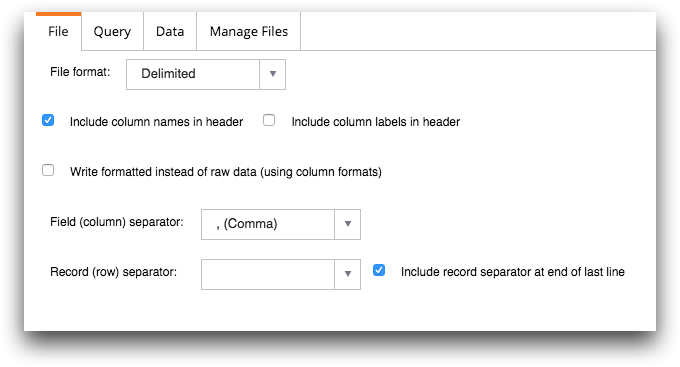File
Settings for customizing the file data.

- File format
-
- Delimited
- Currently, the only file format option is a delimited text file.
- Include column names in header
- When this option is selected, the column header in the file includes the column name for each column.
When this option is cleared, the column header in the file does not include column names.
Note: You can choose to include the column name, column label, neither, or both in the file column header. - Include column labels in header
- When this option is selected, the column header in the file includes the column label for each column.
When this option is cleared, the column header in the file does not include column labels.
Note: You can choose to include the column name, column label, neither, or both in the file column header. - Write formatted instead of raw data (using column formats)
- When this option is selected, the data is saved without any formatting. For example,
in the case of a date, the data would appear in the date form as YYYYMMDD.
When this option is cleared, the data is saved with the display format applied to the column. In the same date example as above, the date may appear as MM/DD/YYYY.
- Field (column) separator
- The options in this drop-down list define the column separator character used to
separate adjacent columns in the text file.
- , (Comma)
- Columns in each row of the table are separated by a comma (,) in the text file.
- (Tab)
- Columns in each row of the table are separated by a tab in the text file.
- | (Stile/pipe)
- Columns in each row of the table are separated by a pipe (|) in the text file.
- : (Colon)
- Columns in each row of the table are separated by a colon (:) in the text file.
- ; (Semicolon)
- Columns in each row of the table are separated by a semicolon (;) in the text file.
- / (Slash)
- Columns in each row of the table are separated by a slash mark (/) in the text file.
- \ (Backslash)
- Columns in each row of the table are separated by a backslash (\) in the text file.
- * (Asterisk)
- Columns in each row of the table are separated by an asterisk (*) in the text file.
- Record (row) separator
- The options in this drop-down list define the record (row) separator character. The
separator is used to indicate the end of each row of the table in the text file.
The row separator is a sequence of one or more characters used to specify the boundary between separate, independent regions in plain text files. In general, the two most commonly used record delimiters in the Insights Platform are CRLF and LF.
- LF (Newline)
- The last column in each row of the table is indicated by the Line Feed (LF) row
separator in the text file.
The LF ('\n', 0x0A) row separator is used in Multics, Unix and Unix-like systems (Linux, OS X, FreeBSD, AIX, Xenix, etc.), BeOS, Amiga, RISC OS, and others.
- CR (Carriage return)
- The last column in each row of the table is indicated by the Carriage Return
(CR) row separator in the text file.
The CR ('\r', 0x0D) row separator is used in macOS.
- CRLF (Carriage return + newline)
- The last column in each row of the table is indicated by the Carriage Return
Line Feed (CRLF) row separator in the text file.
The CRLF ('\r\n', 0x0D 0x0A) row separator is used in Microsoft Windows, DOS (MS-DOS, PC DOS, etc.), DEC TOPS-10, RT-11, CP/M, MP/M, Atari TOS, OS/2, Symbian OS, Palm OS, Amstrad CPC, and most other early non-Unix and non-IBM OSes. Select this option for PC files.
- Include record separator at end of last line
- Some operating systems may require a record separator at the end of the last row to
indicate the end of the file.
When this option is selected, the last column in the last row of the table is indicated by the row separator selected above.
When this option is cleared, the last column of the last row does not have a row separator.
